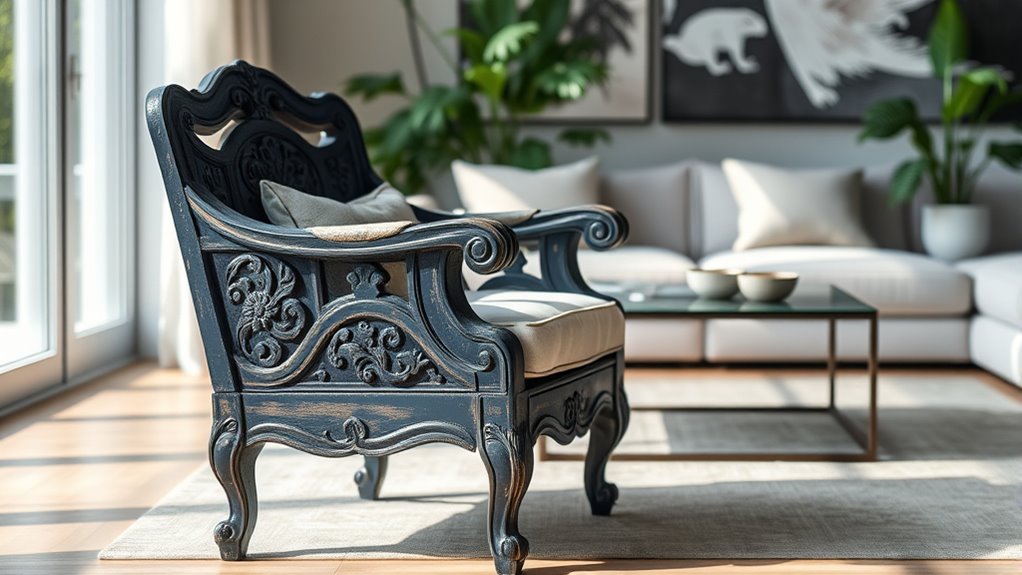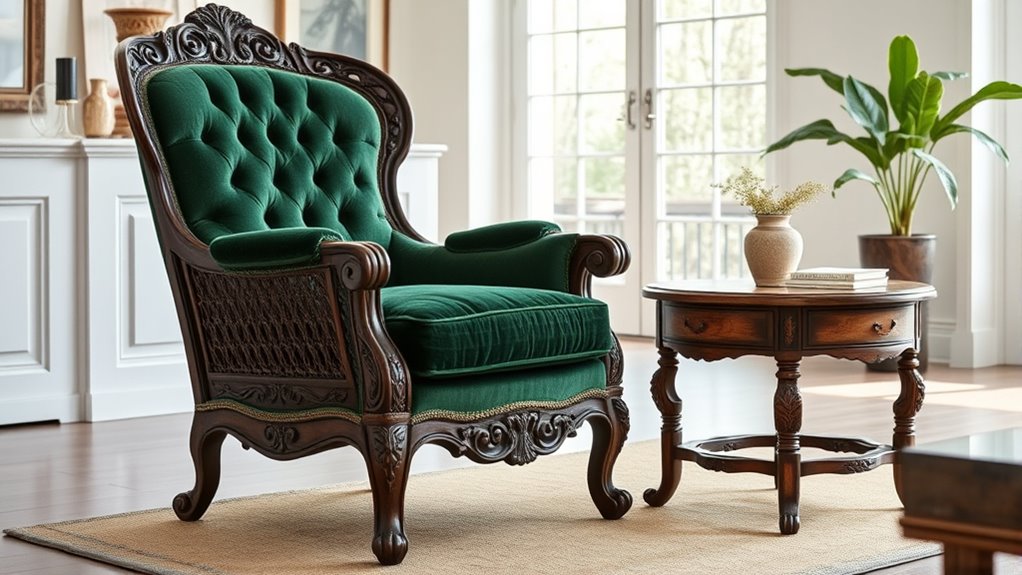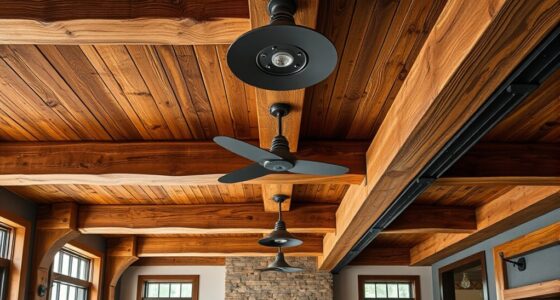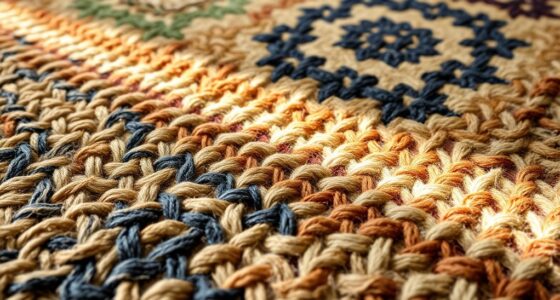Upcycling antique furniture lets you breathe new life into old pieces, blending vintage charm with modern luxury in your home. You can restore and customize items by carefully evaluating their condition, choosing eco-friendly finishes, and adding contemporary touches while preserving unique details. This sustainable approach not only highlights craftsmanship but also creates standout, functional accents. If you want to discover how to transform your antique finds into stylish, eco-friendly focal points, you’ll find valuable tips ahead.
Key Takeaways
- Assess antique furniture for structural integrity and select eco-friendly finishes to ensure durability and sustainability.
- Use restoration techniques like sanding, distressing, or glazing to blend vintage charm with modern elegance.
- Customize pieces with contemporary colors and hardware to complement modern luxury home decor.
- Preserve historical details while adding new finishes to create unique, stylish focal points.
- Prioritize environmentally conscious practices throughout the upcycling process to support sustainability.

Upcycling antique furniture gives you a sustainable way to breathe new life into pieces that might otherwise be discarded. When you decide to restore old furniture, you’re not just saving history—you’re creating something uniquely suited to your modern luxury home. The key to successful upcycling lies in understanding the right restoration techniques and making thoughtful material selections. These steps ensure your piece remains both beautiful and durable, blending vintage charm with contemporary elegance.
Start by evaluating the condition of your antique piece. Look for structural issues, such as loose joints or warped wood, which may require specific restoration techniques like tightening, reinforcing, or replacing damaged parts. When selecting materials, prioritize high-quality, compatible options that match the original construction. For example, choose wood types that replicate the original finish for authentic-looking results, or incorporate modern materials carefully to enhance stability without compromising aesthetic appeal. Material selection isn’t just about appearance; it’s about longevity as well. Opt for eco-friendly paints, stains, and sealants that protect the piece while aligning with sustainable practices. This way, you extend the life of your furniture and reduce environmental impact.
Once you’ve chosen your materials, you can begin the restoration process. Sanding is often necessary to remove old paint, varnish, or superficial damage. Use fine-grit sandpaper to gently prepare the surface without stripping away too much of the original character. When applying finishes, consider techniques like distressing or glazing to add a contemporary touch while retaining vintage details. These restoration techniques allow you to customize the piece, giving it a fresh look that complements your modern decor. Be sure to apply sealants carefully, ensuring they provide a durable protective layer that can withstand everyday use.
Throughout this process, your focus should be on balancing preservation with innovation. Upcycling antique furniture isn’t about making it look brand new but about respecting its history while adapting it to your current style. Using appropriate restoration techniques and material selection enables you to create a piece that’s both functional and aesthetically pleasing. With patience and attention to detail, you transform an overlooked relic into a statement piece that embodies sustainability, craftsmanship, and modern luxury all at once. This approach not only adds character to your home but also supports environmentally conscious choices, making your space truly one of a kind.
Frequently Asked Questions
What Are the Best Finishes for Antique Furniture?
You should choose wood stains that enhance the antique’s natural beauty and match your decor. Protective finishes like polyurethane or wax provide durability and a smooth, polished look. These finishes help preserve the wood and prevent damage from daily use. Opt for a satin or semi-gloss sheen for a balanced, elegant appearance. Properly applied, these finishes give your antique furniture a stunning, long-lasting finish that complements any modern luxury home.
How Do I Identify Valuable Antique Pieces?
To identify valuable antique pieces, start with antique valuation by examining craftsmanship, wood type, and construction techniques. Look for signs of age, such as patina and wear. Research the historical significance of the piece, including maker’s marks or labels. Consult with experts or appraisers to confirm authenticity. Your careful evaluation helps verify you recognize genuine antiques with high value and historical importance, making your collection more meaningful.
Can Upcycling Damage the Original Craftsmanship?
Think of upcycling as a delicate dance—while it can risk damaging craftsmanship, careful preservation techniques minimize this. You need to navigate restoration challenges with patience and skill, ensuring you don’t strip away the piece’s history. Properly applied, upcycling enhances the character of antique furniture without erasing its soul. So, if you handle it thoughtfully, you preserve both its beauty and integrity, giving old treasures a fresh, modern life.
What Tools Are Essential for Upcycling Antique Furniture?
You’ll need a few essential tools for upcycling antique furniture. Power tools like a sander or drill make stripping and drilling easier, saving you time and effort. Paint brushes are vital for applying paint or stain smoothly, ensuring a professional finish. A putty knife helps with filling imperfections, while clamps keep pieces secure during work. With these tools, you can confidently restore and transform your antique furniture into stunning, modern pieces.
How to Choose the Right Modern Accessories for Antiques?
Choosing the right modern accessories for antiques is like finding the perfect puzzle piece. You should seek decorative accents that complement the antique’s character without overpowering it. Incorporate contemporary art pieces that add a fresh touch while respecting the vintage charm. Think about balance and contrast, blending the old with the new seamlessly. This approach guarantees your antiques become statement pieces that elevate your modern space effortlessly.
Conclusion
By upcycling antique furniture, you’re not just restoring old pieces; you’re embodying the spirit of Daedalus, transforming the ancient into something timeless and exquisite. With each brushstroke and careful touch, you breathe new life into history, creating a space that echoes both past and present. Embrace this art of renewal, and let your home tell a story of craftsmanship and ingenuity that rivals the legends of old.









